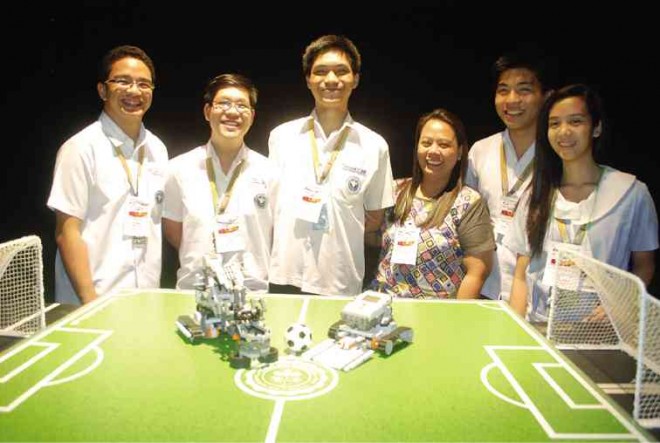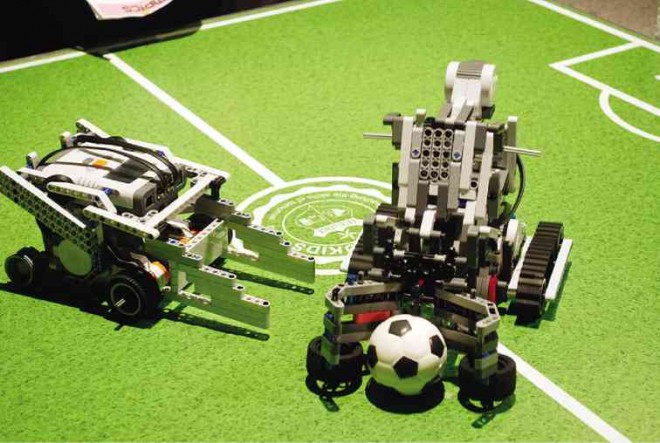Robolympics turns sci-fi ideas into reality

THE WINNING team: Wenceslao, Tangi, Guyguyon, Hortaleza, Bengco, Gonzalez. INQSnap this page to watch a video. PHOTOS BY ARNOLD ALMACEN
The recent Robolympics of the TechnoKids IT Cup proved that youngsters could easily assemble what was not too long ago merely a science-fiction idea.
Some 30 high school student teams at De La Salle-College of Saint Benilde designed robots in an hour and a half for a mission revealed only minutes before the countdown began.
Each team sought to build two vehicles that would score points and protect goals in a soccer-like setting. The cars, designed using TechnoKids’ robot kits, were controlled through a smartphone application (app).
Two hours of action in a single-elimination format saw teams pushing opponents’ robots out of the mini-field. The talon-like entry of Immaculate Conception Cathedral School in Cubao, Quezon City, won.
For the team of four boys and a girl reserve player, strategy was key, coach Maria Carmen Hortaleza said.
“Of the first four, two were good at building. The other two were good with controls and tactics,” she said. Hortaleza said she began assembling her dream team since classes started.
“For almost one month, we trained every day from 3:50 to 7 p.m., Monday to Friday,” she told the Inquirer.
John Guyguyon, one of the builders, said they trained for many scenarios. “The first I could recall [was] to maneuver through a maze … . Next was racing, where we had to get the parts.”
Their scores came from a design for carrying objects, whose pincer grabs the ball and raises it up. Their goalkeeper, “sumo-bot,” was essentially just a distraction, said its controller Ivan Wenceslao.
“Aside from the skills, I wanted them to learn to be persevering … and to make wise decisions. I let them decide on a lot of aspects of the designs,” Hortaleza said.
Those values, as well as teamwork and trust in one another, were picked up by her overwhelmed team, said Raphael Christian Bengco, who commandeered the main unit.
Toni Gonzalez, the reserve player, was glad the team kept its cool even when opponents were raising their voices at each other.
The drama was a regular feature at the venue, as units broke apart, falling to the ground from as high as a ping-pong table, or as batteries ran low midway through a match.
For St. Augustine’s School of Iba, Zambales, the delegation that came from the farthest place, the problem was installing the wrong app in one of their smartphones. That made the team’s goalkeeper useless.
But the team fought on because it did not want it said that theirs was the team that traveled for five hours but did not even try, said James Chrystian Alvero, team member. The team completed one match.
But members said they at least learned to distribute the workload among themselves. Kim Frias said, “We divided the roles among ourselves … one did the upper part and the other did the chassis.”
Alvero said they learned to compromise, especially when they had to reconcile their designs.
Francis Joshua Pangan said he learned robot-making, while Gem Michael Nieva stressed teamwork. (They were now “tropa,” Frias said.)
Pangan and Nieva were newcomers to robotics. The course was offered in the fourth-year curriculum but they were in Grades 7 and 8 in the new K to 12 (kindergarten to Grade 12) basic education system.
TechnoKids, founded in Canada and launched in the country in 2002, provided content for clients’ computer curriculum, explained chief curriculum manager Ryan Ong.
Offerings varied per year level and also included Photoshop and animation.
The company imports new technology, such as robot kits for the Robolympics and, just recently, the 3D printer. It lends gadgets to schools and takes them back for inventory during the long school break.
Majority of clients, around 50 schools mostly with grade school and high school levels, were based in Metro Manila and nearby provinces, Ong said. TechnoKids is currently in talks with schools as far as Mindanao.
Started in 2008, the Philippines’ IT Cup has been an achievement test for clients.
“Initially, we started with just a quiz bee (on information technology) for grade and high schools. That went around for three or four years,” Ong said.
Then, they decided to hold a multimedia secondary event, where students were challenged to make Web pages and animations. These were replaced later by robotics, whose “mission” changed yearly.
“Today, we added it all up,” Ong said. “Every year we change the theme and the challenge. It doesn’t stay the same except for the quiz bee.”
The best of the best were sent to the competitions, he said. With the theme “DigiNation: Extended Exploration of Expanded Realities,” this year’s edition had 400-plus participants from about 30 schools.
“We chose [the theme] mainly because now most people were wired [and familiar with the] digital [world], but they were missing the unity aspect, collaboration … [we made] sure they worked together,” Ong said.
The theme, he said, meant “to emphasize the unity that we want them to be more conscious about.”
